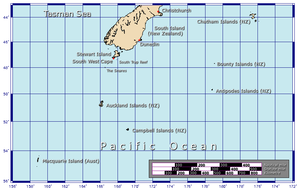Cape Expedition
| Cape Expedition | |
|---|---|
| Part of World War II | |
 Map of New Zealand's subantarctic outlying islands |
|
| Location |
New Zealand's subantarctic outlying islands |
| Objective | Coastwatching and scientific work |
| Date | 1941–1945 |
| Executed by | Public Works Department |
| Outcome | No enemy ships sighted, valuable meteorological and other scientific data collected |
The Cape Expedition was the deliberately misleading name given to a secret five-year wartime program of establishing coastwatching stations on New Zealand’s more distant uninhabited subantarctic islands. The decision to do so was made by the New Zealand Government’s War Cabinet in December 1940, with the program terminating at the end of the Pacific War in 1945.
It was suspected that the 6,000-ton German merchant vessel Erlangen, which had sailed from Dunedin, supposedly for Australia, on 26 August 1939 – shortly before war had been declared in Europe – had, instead, supplemented her meagre coal reserves with timber from the Auckland Islands and headed for South America. The suspicion was later confirmed when the first coastwatchers in the program found areas of newly cut Southern Rata forest at Carnley Harbour on Auckland Island. Moreover, the loss of the ships SS Holmwood and MS Rangitane to German raiders in November 1940 gave rise to the suspicion that the raiders were using the subantarctic islands as bases.
The Cape Expedition program was managed by the Public Works Department's Aerodrome Services Branch. The auxiliary schooner Tagua, carrying the first contingent of coastwatchers, sailed from Wellington on 5 March 1941. The ship reached the Aucklands on 10 March and sheltered in the natural harbour of Port Ross before proceeding to Carnley Harbour, arriving there on the 13th.
...
Wikipedia
